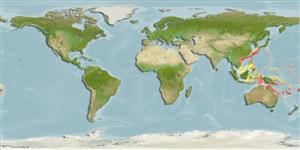>
Perciformes/Serranoidei (Groupers) >
Anthiadidae (Fairy basslets or Streamer basses)
Etymology: Plectranthias: Greek, plektron = anyhting to strike with, spur + Greek, anthias = a fish, Sparus aurata (Ref. 45335).
Environment: milieu / climate zone / depth range / distribution range
Ecologia
marino associati a barriera corallina; distribuzione batimetrica 80 - 300 m (Ref. 26833). Subtropical
Distribuzione
Stati | Aree FAO | Ecosystems | Presenze | Point map | Introduzioni | Faunafri
Western Pacific.
Size / Peso / Age
Maturity: Lm ? range ? - ? cm
Max length : 11.1 cm SL maschio/sesso non determinato; (Ref. 40960)
Raggi dorsali molli (totale): 17. Body moderately deep, depth 2.3 in SL. Head not completely scaled. Ventral margin of preopercle with no antrorse spine (Ref. 43101). Second soft dorsal not filamentous and third dorsal spine longest. Second branched caudal rays filamentous and a small red spot on the upper base of caudal fin. Body with 2 oblique red bands and a third narrow one from eye to thorax (Ref. 26833).
Life cycle and mating behavior
Maturità | Riproduzione | Deposizione | Uova | Fecundity | Larve
Chen, J.-P. and K.-T. Shao, 2002. Plectranthias sheni, a new species and P. kamii, a new record of anthiine fishes (Perciformes: Serranidae) from Taiwan. Zool. Stud. 41(1):63-68. (Ref. 43101)
IUCN Red List Status (Ref. 130435)
Threat to humans
Harmless
Human uses
Informazioni ulteriori
Nomi ComuniSinonimiMetabolismoPredatoriEcotossicologiaRiproduzioneMaturitàDeposizioneSpawning aggregationFecundityUovaEgg development
BibliografiaAcquacolturaProfilo di acquacolturaVarietàGeneticaElectrophoresesEreditarietàMalattieElaborazioneNutrientsMass conversion
Strumenti
Special reports
Download XML
Fonti Internet
Estimates based on models
Preferred temperature (Ref.
123201): 16.7 - 26.4, mean 20.2 °C (based on 75 cells).
Phylogenetic diversity index (Ref.
82804): PD
50 = 0.5000 [Uniqueness, from 0.5 = low to 2.0 = high].
Trophic level (Ref.
69278): 4.0 ±0.6 se; based on size and trophs of closest relatives
Resilienza (Ref.
120179): Alto, tempo minimo di raddoppiamento della popolazione meno di 15 mesi (Preliminary K or Fecundity.).
Fishing Vulnerability (Ref.
59153): Low vulnerability (10 of 100).
